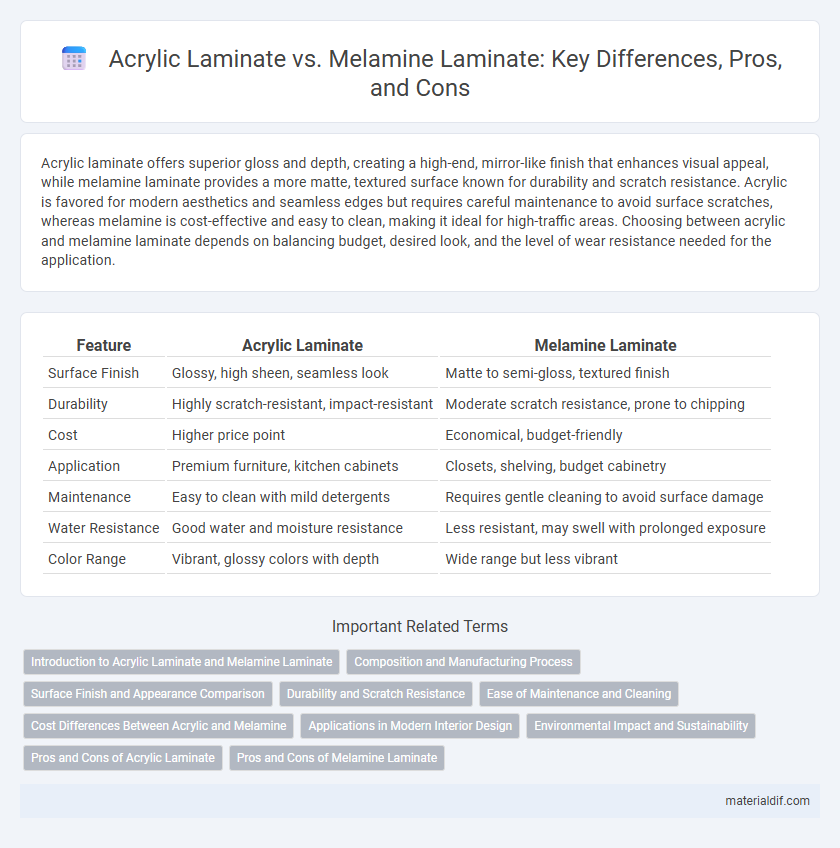Acrylic laminate offers superior gloss and depth, creating a high-end, mirror-like finish that enhances visual appeal, while melamine laminate provides a more matte, textured surface known for durability and scratch resistance. Acrylic is favored for modern aesthetics and seamless edges but requires careful maintenance to avoid surface scratches, whereas melamine is cost-effective and easy to clean, making it ideal for high-traffic areas. Choosing between acrylic and melamine laminate depends on balancing budget, desired look, and the level of wear resistance needed for the application.
Table of Comparison
| Feature | Acrylic Laminate | Melamine Laminate |
|---|---|---|
| Surface Finish | Glossy, high sheen, seamless look | Matte to semi-gloss, textured finish |
| Durability | Highly scratch-resistant, impact-resistant | Moderate scratch resistance, prone to chipping |
| Cost | Higher price point | Economical, budget-friendly |
| Application | Premium furniture, kitchen cabinets | Closets, shelving, budget cabinetry |
| Maintenance | Easy to clean with mild detergents | Requires gentle cleaning to avoid surface damage |
| Water Resistance | Good water and moisture resistance | Less resistant, may swell with prolonged exposure |
| Color Range | Vibrant, glossy colors with depth | Wide range but less vibrant |
Introduction to Acrylic Laminate and Melamine Laminate
Acrylic laminate is a high-gloss, durable surface material made by layering acrylic resin over a substrate, offering superior scratch resistance and vibrant color retention compared to traditional laminates. Melamine laminate consists of a resin-infused paper layer bonded to particleboard or MDF, known for its cost-effectiveness and availability in various textures and finishes. Both materials are widely used in furniture and cabinetry, with acrylic laminate favored for premium, glossy aesthetics and melamine for budget-friendly, versatile applications.
Composition and Manufacturing Process
Acrylic laminate consists of a solid acrylic resin layer that provides high gloss and superior durability, created through a process of casting or continuous polymerization on composite panels. Melamine laminate is produced by impregnating paper layers with melamine resin and fusing them under heat and pressure onto particleboard or MDF substrates, resulting in a cost-effective, scratch-resistant surface. The acrylic manufacturing process offers a seamless and more impact-resistant finish, while melamine uses a layered paper composition for varied patterns but with less resilience.
Surface Finish and Appearance Comparison
Acrylic laminate offers a high-gloss, reflective surface with exceptional brightness and depth, creating a sleek, modern aesthetic ideal for premium furniture and cabinetry. Melamine laminate features a matte or lightly textured finish, providing durability and resistance to scratches but with a less vibrant and less luxurious appearance compared to acrylic. Acrylic's superior clarity and gloss enhance color vibrancy and visual richness, making it the preferred choice for contemporary designs emphasizing surface finish and appearance.
Durability and Scratch Resistance
Acrylic laminate exhibits superior durability and scratch resistance compared to melamine laminate due to its hard, non-porous surface that withstands daily wear and tear effectively. Melamine laminate, made from resin-impregnated paper, is more prone to scratches and chipping under heavy use. The enhanced abrasion resistance of acrylic laminate makes it ideal for high-traffic areas and furniture requiring long-lasting aesthetic appeal.
Ease of Maintenance and Cleaning
Acrylic laminate offers superior ease of maintenance as its non-porous surface resists stains, fingerprints, and moisture, making cleaning quick with just a damp cloth and mild detergent. Melamine laminate, while budget-friendly, tends to be more susceptible to scratches and surface wear, requiring gentler cleaning methods to prevent damage. The durability and smooth finish of acrylic laminate translate to longer-lasting cleanliness with minimal effort.
Cost Differences Between Acrylic and Melamine
Acrylic laminate typically costs significantly more than melamine laminate due to its superior gloss finish, durability, and aesthetic appeal. Melamine laminate is a budget-friendly option favored for cost efficiency in large-scale projects or budget-conscious renovations. The price gap between acrylic and melamine often reflects variations in material composition, manufacturing processes, and long-term maintenance needs.
Applications in Modern Interior Design
Acrylic laminate offers a high-gloss, premium finish ideal for contemporary kitchen cabinets and furniture, providing superior scratch resistance and color vibrancy compared to melamine laminate. Melamine laminate is widely used for budget-friendly cabinetry and shelving, favored for its durability and ease of maintenance in commercial and residential interiors. Both materials serve distinct roles in modern interior design, with acrylic laminates enhancing aesthetic appeal and melamine laminates emphasizing cost-effective functionality.
Environmental Impact and Sustainability
Acrylic laminate offers superior durability and a longer lifespan compared to melamine laminate, reducing the frequency of replacements and overall waste. Melamine laminate, often produced with formaldehyde-based resins, can emit higher levels of volatile organic compounds (VOCs), negatively impacting indoor air quality and environmental health. Acrylic's higher recyclability and low-VOC composition contribute to a more sustainable choice in eco-friendly interior design applications.
Pros and Cons of Acrylic Laminate
Acrylic laminate offers superior gloss and a more vibrant, durable finish compared to melamine laminate, with excellent resistance to scratches and UV rays, making it ideal for high-end cabinetry and furniture. It tends to be more expensive and less resistant to impact than melamine, which can chip or crack under heavy stress. Acrylic's seamless edges and enhanced color retention provide a premium aesthetic, while its susceptibility to chemical damage requires careful maintenance.
Pros and Cons of Melamine Laminate
Melamine laminate offers cost-effective durability and resistance to scratches, stains, and heat, making it a practical choice for budget-conscious applications. However, it lacks the high-gloss finish and depth of color seen in acrylic laminate, which can affect the overall aesthetic appeal. Melamine's edge banding can be less seamless and more prone to chipping compared to acrylic, reducing its lifespan in high-use environments.
Acrylic Laminate vs Melamine Laminate Infographic

 materialdif.com
materialdif.com